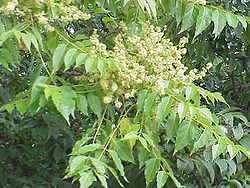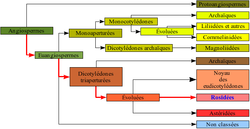Simarubaceae
- Simarubaceae
-
Simaroubaceae
La famille des Simaroubacées est une famille de plantes dicotylédones. Ca circonscription est très dicutée. Selon Watson & Dallwitz elle comprend 50 espèces réparties en une vingtaine de genres :
- Ailanthus, Amaroria, Brucea, Castela, Eurycoma, Gymnostemon, Hannoa, Harrisonia, Iridosma, Laumoniera, Perriera, Perrierodendron, Picrolemma, Pleiokirkia, Quassia, Samadera, Simaba, Simarouba, Soulamea.
Ce sont des arbustes et des arbres, aux terpénoïdes caractéristiques, des régions sub-tropicales à tropicales largement répandus.
Liens externes
 Portail de la botanique
Portail de la botanique
Catégories : Simaroubaceae | Famille botanique
Wikimedia Foundation.
2010.
Contenu soumis à la licence CC-BY-SA. Source : Article Simarubaceae de Wikipédia en français (auteurs)
Regardez d'autres dictionnaires:
Simarubacĕae — Simarubacĕae, Pflanzenfamilie aus der Klasse der, Anacardiaceae; Bäume u. Sträucher, mit abwechselnden, meist gefiederten, selten einfachen Blättern, ganzrandigen Blättchen, ohne Nebenblätter, vollständigen. od. durch Fehlschlagen unvollständigen … Pierer's Universal-Lexikon
Симарубовые — (Simarubaceae) сем. двудольных раздельнолепестных растений порядка Terebinthinae. Это высокие деревья или кустарники с корою, богатою горькими веществами и склеренхимными клетками; листья у них попеременные (супротивные у Brunellia), без… … Энциклопедический словарь Ф.А. Брокгауза и И.А. Ефрона
Wettstein system — A system of plant taxonomy, the Wettstein system recognised the following main groups, according to:cite book| author = R. Wettstein|year = 4th edition, 1935|title = Handbuch der Systematischen Botanik * I. phylum Schizophyta *::: 1. classis… … Wikipedia
List of plants of Caatinga vegetation of Brazil — This is a list of plants found in the wild in Caatinga vegetation of Brazil. Additions are currently being made to this list.See also: * List of plants of Amazon Rainforest vegetation of Brazil * List of plants of Atlantic Forest vegetation of… … Wikipedia
Bessey system — A system of plant taxonomy, the Bessey system was published in:cite journal|author = Charles E. Bessey|year = 1915|title = The phylogenetic taxonomy of flowering plants|journal = Annals of the Missouri Botanical Garden|volume = 2|pages =… … Wikipedia
Similajau National Park — The Similajau National Park situated in Bintulu Division (about 30 km from Bintulu Town) the national park provides recreational ground for the people within the central region of Sarawak. It has one of the most beautiful coastal areas in… … Wikipedia
Айлантус — (Ailanthus Desf.) на молуккском наречии Ailanto значит небесное дерево. Высокие деревья из сем. Simarubaceae с непарноперистыми листьями, поперек стоящие листки цельнокрайние или выемчато зубчиковатые. На оконечности ветвей помещаются… … Энциклопедический словарь Ф.А. Брокгауза и И.А. Ефрона
Квассия — (Quassia L.) род растений из сем. Simarubaceae. Известен только один вид Quassia amara L., кустарник или деревцо от 2 до 5 м высотою, дико растущее в Суринаме и разводимое в Вест Индии, на С. Бразилии и в Гвиане. Кора у К. зеленая; листья… … Энциклопедический словарь Ф.А. Брокгауза и И.А. Ефрона
Лекарственные растения* — или целебные растения (plantae officinales [см. табл. I и II Лекарственные растения]) называемые также аптекарскими вообще зависят от различных веществ, специально свойственных каждому из них. Вещества эти нередко могут быть искусственно выделены … Энциклопедический словарь Ф.А. Брокгауза и И.А. Ефрона
Медоносные растения — Так наз. растения, у которых находятся особые медовые железки, медовики, или нектарники (см.), выделяющие сладкую сахаристую жидкость, так называемый нектар, или мед. М. растений чрезвычайно много; они встречаются в различных семействах цветковых … Энциклопедический словарь Ф.А. Брокгауза и И.А. Ефрона




